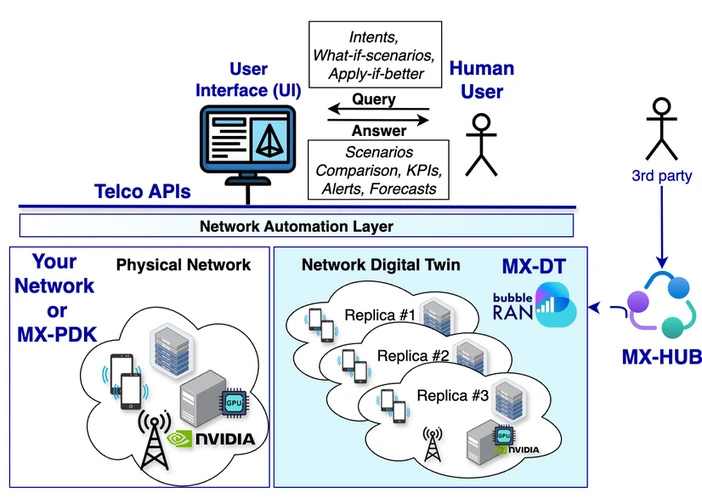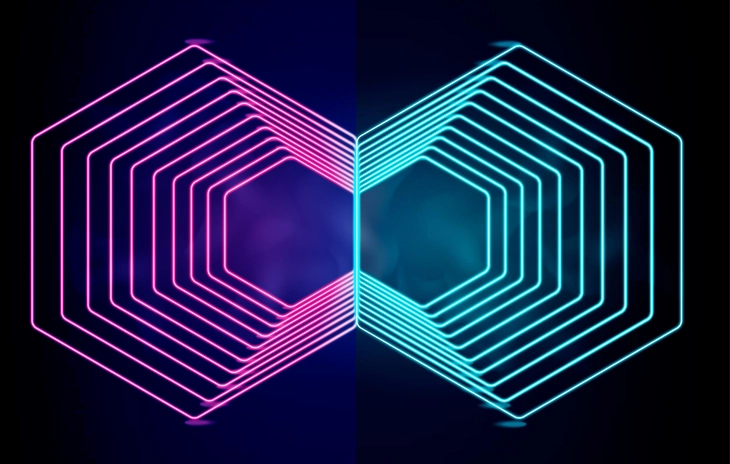🏷️ €19900 | Base Price
includes MX-DT License and 1-year Updates and Support








📰 What is MX-DT?
MX-DT provides a scalable 5G compliant digital-twin environment with 5G UE in-the-loop, miroring the network at scale and reproducing operational data with high fidelity. It supports parallelised replicas, synchroization, and AI-driven analysis for rigorous planning, experimentation, and optimisation of network decisions and operations.
💡 Getting started is simple: choose or customize a network blueprint from our portfolio, and deploy it with a single command at scale:
bash$ brc install digital-twin 5g-oran-ndt.yaml
Why MX-DT ?
- Spawn parallel replicas: mirror RAN and Core with high fiedelity in both emulation and over-the-air.
- Decouple from live changes: run synced or freeze at any point in time.
- Safely: test hypothesis, apply actions and see the results before production.
- Scope: Clone a region, a slice, or a site to save resources.
- O-RAN: integrate with MX-AI, MX-PDK, SMO/RIC via open Telco APIs; built-in multi-vendor support with no lock-in.

What’s Included?
- MX-DT Core: Twin orchestrator with state perceptors and replicators for RAN, vRAN, C-RAN, Core VNFs and transport.
- Starter Twin Templates: gNodeB, L2/L3, AMF/SMF/UPF, transport layers, VNFs.
- Scenario Kit: traffic mirroring, synthetic generators, fault injection, mobility, spectrum toggles.
- SDK / CDK: build custom mappers, generators and analytics pipelines.
- MX-HUB Access: templates, scenarios, dashboards; share models with the community.
- Web GUI & CLI: create, run, compare and export reports; 3D visualisations.
- Virtual & Physical Twins: deploy via MX-ORS or connect to physical equipment.
Tiered Packaging
| Tier | What’s inside |
|---|---|
| Base | (1) Parallel & scoped twins, (2) Live-synced & time-locked, (3) Traffic mirroring & scenarios, (4) Reports & dashboards. |
| Pro | Closed-loop automation and optimization powered by O-RAN and MX-AI |
| Custom | 💡 Bespoke models & workflows |
Capabilities at a Glance
| Capability | Description |
|---|---|
| Parallel replicas | Spawn multiple twins, scoped to cells, slices or regions. |
| Live & time-locked | Keep synced with production or freeze at a past state. |
| Scenario & fault kit | Inject traffic, faults, mobility and spectrum changes. |
| Apply-if-better | Compare dashboards; push only improvements to live. |
| Open APIs & MX-HUB | O-RAN-friendly, share models via MX-HUB. |
| Virtual & physical twins | Combine parallel E2E network emulation and over-the-air twins in one deployment. |
Benefits at a Glance
| Benefit | Description |
|---|---|
| O-RAN-friendly & Open | R1/A1, SMO/RIC ready; share & reuse via MX-HUB. |
| Risk-free deployment | Test in a twin; apply only improvements. |
| Better planning | Visualise capacity, coverage, energy. |
| Reduced downtime | Spot issues early; plan interventions. |
| Fast iterations | Parallel twins = rapid experimentation. |
| Choice of deployment | Run virtual or physical twins; scale from labs to field. |
Practical Use-Cases
| Use-Case | Description |
|---|---|
| Clone & Tune Regions | Mirror a region, slice, or cluster; tweak spectrum and virtualization. |
| Replay & Analyse Incidents | Freeze a past twin, replay traffic, inject faults to diagnose. |
| Design 5G/6G Roll-outs | Plan small-cell/vRAN deployments; test mobility and edge. |
| Enable Closed Loops | Validate RIC policies; promote only improvements. |
| Academia & Training | Deterministic labs, algorithm comparisons, MX-HUB sharing. |
Need more information ?
Check our frequently asked questions about MX-DT here below and get quick replies.
To answer your unique deployment and projects needs, we can plan a live demo, help you forward with a requirements questionnaire, and connect you with our partner ecosystem.
Frequently Asked Questions
1️⃣ Can MX-DT run fully on-prem?
Yes, deploy twins on your servers or edge nodes. MX-DT support hyper-scale deployment on public clouds, GKE, based on Terraform.
2️⃣ Do you integrate with our SMO/RIC?
Yes, MX-DT is O-RAN-friendly (R1/A1) with open APIs for O-RAN SMO and RIC APIs.
3️⃣ How do we create and reuse templates?
Via MX-HUB, pull templates or push your own with versioning.
4️⃣ What hardware do we need?
All depends on the scale at which you plan to twin the physical network. Min requirements CPU requirements are: 16-24 cores at 4GHz per NDT replica sets. MX-DT removes the need for radio frontend if used in emulation mode.
5️⃣ How is data privacy handled?
Data stays local on-prem. Audit logging, RBAC, and federated learning are supported.


